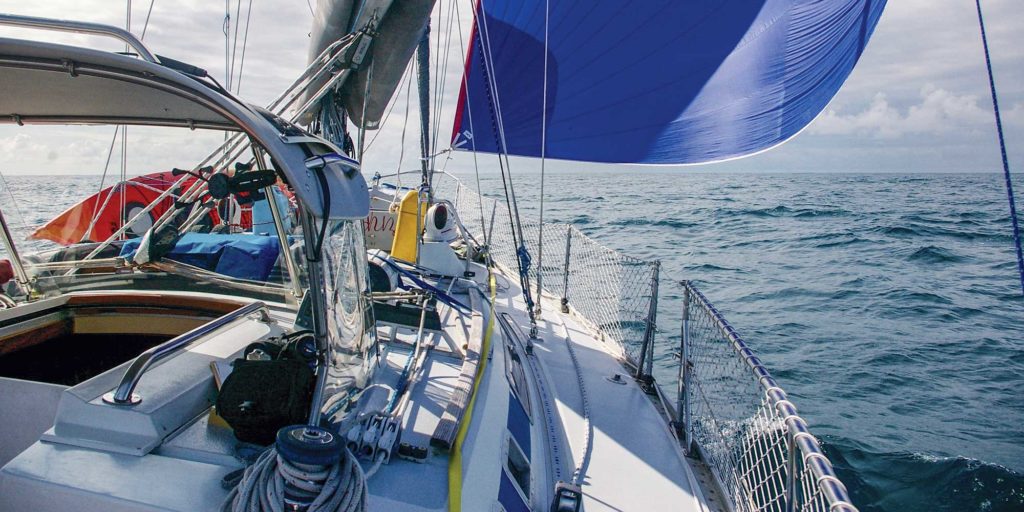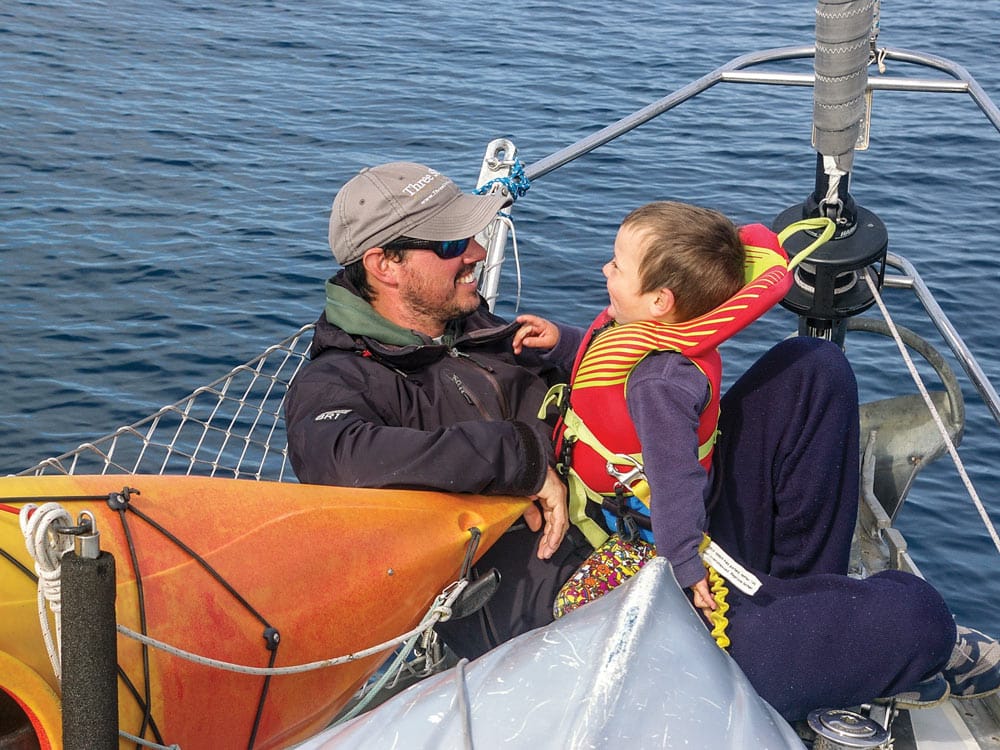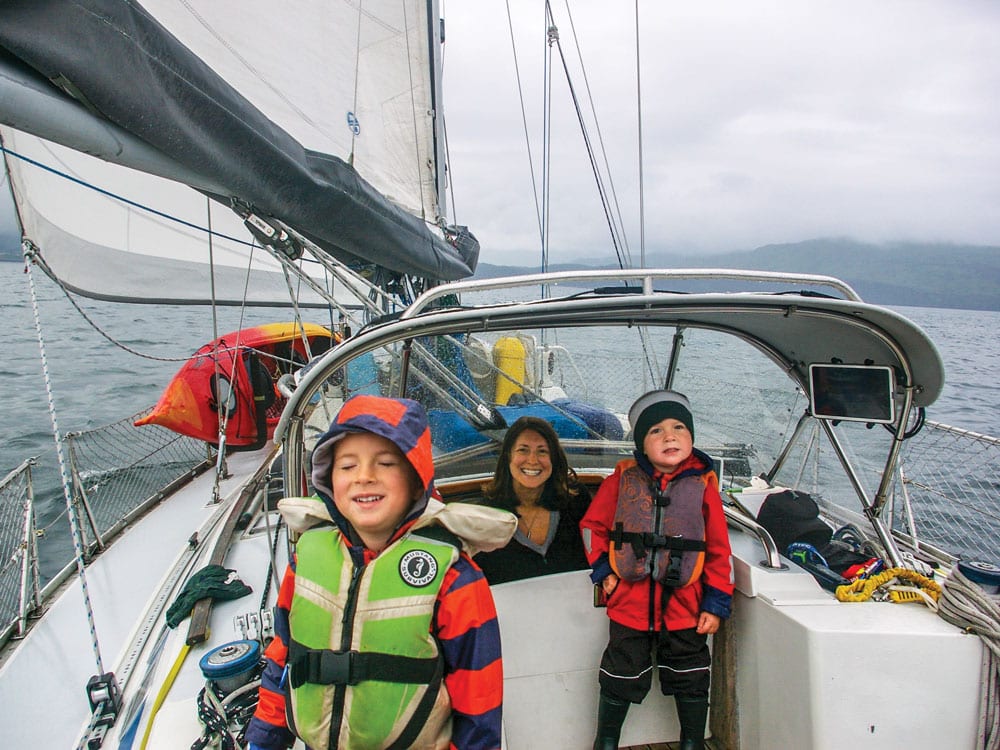
Seated comfortably in the cockpit on my second watch of the night, I set my book down on the cushion next to me to check the spinnaker and mainsail, and scan the horizon. All good.
A steady southerly drew us forward toward Kodiak Island, which was still a couple hundred miles to the west. Along with the swell, I could see the breeze on the water, illuminated by the moon. Over my shoulder and just above the southern horizon, it was full and glowing bright, sending a shaft of light across the water that seemed to extend all the way to us.
Fine on the port bow and above the mast, Jupiter twinkled like a sparkling, icy jewel. To starboard, the sun had set just over two hours prior, but a dusky, bruise-colored sky remained. Basically, it was still light out.
Picking up our ship’s log, I slid the green mechanical pencil from the top of the clipboard and, after the time and date — 0120 on July 8 — the first note I made was short and to the point: “Gorgeous early morning. Stunning.”
The next thing I jotted down was the distance since leaving Sitka: 242 nautical miles. We were nearly smack in the middle of the Gulf of Alaska, and I couldn’t have been happier. My wife, Jill, and our boys, Porter, 4, and Magnus, 2, slept peacefully down below, snuggled in their bunks with the sway of the boat and sound of the ocean.
In my glory. I was home.
Getting Here
Our track from Sitka to Kodiak started on a rainy Fourth of July. After three beautiful weeks cruising with us aboard our 1984 Grand Soleil 39, Yahtzee, Jill’s mom was set to fly out of Sitka on the fifth, and then it was go time for us. But where?
Having spent two and a half months in southeast Alaska already, we were set to move. Jill and I get antsy, and we wanted to see more of her massive home state. Plus, Yahtzee needed to stretch her legs on the ocean again. So we devised a monthlong plan that would have us sailing north to Prince William Sound, west to the Kenai Peninsula and then south to Kodiak Island. Cruising plans are tough though, especially for us. We don’t like them.
Instead, we defer to our tried-and-true method of letting the weather decide and then routing accordingly. The weather rules, and in Alaska, especially on the formidable Gulf of Alaska, it’s everything. Being in Sitka and looking for a weather window to head north, what we didn’t want was anything out of the north. We were absolutely not beating, and if the wind was going to be west, it better be moderate to light, because there is a lot of fetch on the Gulf for a nasty swell to develop. And if we didn’t get the weather we liked, we’d just make a different plan. Simple as that.
When I started analyzing what weather we’d see upon the vast reaches of the Gulf from July 6 to about July 10, I noticed something we’d like, a southerly wind. If that forecast held, Prince William Sound was a green light.
As go time neared, the southerly forecast was staying firm, but the wind was supposed to be light at times, moderate at others. No problem, I thought. Let’s just get out there and see what we’ve got. Clearing Sitka’s breakwater on July 6, Jill’s birthday, Porter and I raised the mainsail and turned west toward the open ocean — destination unknown.

At that point, we still hadn’t decided where we were headed exactly, and were going to leave it up to the wind. Moving out past conical Mount Edgecumbe, I assessed our current situation, plus the latest weather information we had, and gave an analysis as to what we could expect over the next three to four days. Just before losing cell service, I texted my mom and dad to update Yahtzee‘s float plan: “The way the wind is shaping up on the Gulf of Alaska, don’t be surprised if we end up on Kodiak Island. But we probably won’t make the decision for a day or two.”
We lost cell service, and just like that, Yahtzee spilled out into the North Pacific Ocean, sailing fast on a broad reach to the west-northwest. That’s when we seriously started thinking about Kodiak as our first landfall.
Knowing the southerly wind was going to be light over the next three to four days, we reasoned, why try to slog downwind when we could keep some apparent wind whipping through the sails while power-reaching fast to the west? We could essentially sail across the wind on a faster beam reach, and then from Kodiak we could turn north and hit the Kenai Peninsula before ending up in Prince William Sound. Decisions, decisions.
The Passage
Shortly after clearing the Southeast Alaska coast, we settled onto our fastest point of sail, flying our big blue asymmetrical spinnaker. Beam-reaching due west now in a light southerly, our options turned into only one outcome: We were going to Kodiak Island.
It was about this time when the sun came out in earnest. Don’t get me wrong, we don’t mind the rain, but after several weeks of seemingly unending downpours, drizzle and gray skies, the Gulf of Alaska rewarded us with splendid sunshine, blue skies and puffy popcorn clouds that were reminiscent of trade-wind passages Jill and I had experienced years before.
As was predicted, though, the southerly wind came and went. Up and down went the spinnaker. In and out rolled the genoa. And on and off went the engine. From Sitka, we had roughly 550 miles to go until Kodiak Island, but the distance never seemed to matter. Ever.
In the realm of time and space, we hadn’t really planned to sail all the way to Kodiak when we left, but deciding to go there while already underway didn’t really seem much of a bother. We plodded along happily, slept, ate, stood watch, played, blew bubbles, read and horsed around like we would have on any normal daysail from point A to B.

But the reality of our situation was that we were crossing a very large body of water that, even in summertime, is known for being inhospitable to commercial fishermen, let alone recreational sailors. From Edgecumbe Point, near Sitka, to the channel entrance to St. Paul’s Harbor, Kodiak Island, we didn’t see a single boat. Nearly four days and nights with no vessel traffic. None.
I guess that’s saying something, though our reality was we were just moving with a favorable breeze and nearly sailed the rhumb line along the entire route. We might not have come across another human soul out there, but the North Pacific Ocean wilderness and its beauty more than made up for any human contact we ever could have had.
Along the way, we spotted every manner of seabird, including the ever-present black-footed albatross, shearwaters, puffins, gulls and birds we still don’t know how to identify. Pacific white-sided dolphins played on the bow wake at 0400. Minke whales breached around us on a daily basis, and a large pod of orcas passed on our starboard side one night during dinner in the nonchalant way that residents of our familiar San Juan Islands wave by just raising a finger or two off the steering wheel to signal hello. Hello, indeed.
Overall, our spinnaker was everyone’s best friend. Not only did it provide the speed we needed to beam-reach smoothly to the west on a forgiving sea, but it was also a source of work and banter as it went up and down with the rise and fall of the wind. And when the kite or genoa weren’t flying, it was up to our engine to pick up the slack and keep us moving toward a landfall that always seemed very distant yet easily attainable.
Besides ably and confidently standing her night watches, Jill is an absolute wizard offshore and can keep a crew of kids, men or women going no matter what the conditions. Fortunately, the weather was mostly flawless, and her steady hand at passagemaking with a crew of 2- and 4-year-old boys was a sight to behold. Sure, when all was said and done, we had our moments as a family, but for the most part, we could have kept going, day after day after day.
As for our own wildlife, Magnus and Porter found a rhythm offshore that was all their own. Yes, they acted their ages at times, but for the most part they were the kids who had grown up on Yahtzee since they were hours old. Trimming sheets, walking decks with harnesses and tethers, begging to steer, eating everything in sight and reading everywhere possible on the boat, they didn’t seem to skip a beat. And when I think about their overall behavior at sea, I have to say they are true watermen, practicing knots, calling out wave troughs and crests, telling me which line is which, and so on.
Landfall
Just like that, four glorious days of sunshine, sailing and a bit of motoring came to an end much how the planning phases of the voyage had begun — in the rain. We were sopping wet, but at least used to it since we’d been cruising year-round for three years in Oregon, Washington, British Columbia and Alaska. But this passage was our family’s longest together, and was, by all measures, one of the most memorable experiences we’ve had aboard Yahtzee.
Approaching the verdant and unfamiliar mountains of Kodiak Island, it was hard to believe we were actually seeing this. Had we even meant to come here in the first place?
Clearing the safe water and lateral buoys into St. Paul Harbor, I jibed us while motorsailing, and then 2-year-old Magnus said in a matter-of-fact sort of way, “Dad, shut off the engine. Let’s sail in.” I could hardly believe my ears, yet it seemed fitting.
Shutting down the engine and sheeting in to clear the buoys and fetch the harbor entrance, I had almost forgotten where we were and how we’d arrived here.
In my mind, I guess, it didn’t really matter. We were all home on the sea — in our glory.
Andy Cross and family have been cruising and living aboard their Grand Soleil 39, Yahtzee, for over six years.








